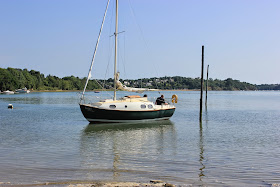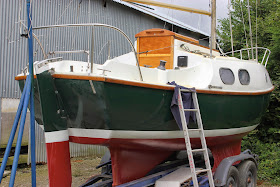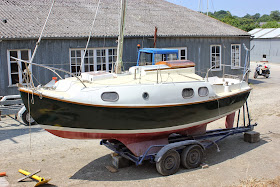Dave and Natalie bought this old English narrow boat on a
French canal ‘as seen’ for a remarkably
good price. It had languished on the
water for six years, used only occasionally as a weekend cottage at the
beautiful Breton village of Evran. Dave took a risk but not a huge one. He’s a
skilled seaman and has already restored a Channel Islands 22 motor vessel –
bringing her back to, and then beyond, her initial spec. Paul, his good friend
has done similar restoration jobs on vintage cars.
Having bought the vessel they had the Volvo Penta engine
running within half a day and then they discovered that the value of the wood-burning
stove installed aboard almost covered the price paid for the entire vessel. In
effect Dave bought a fully functioning eleven meter steel vessel for the price
of a new stove. What’s more, the range of gear and equipment on board was pretty
comprehensive – even down to cutlery, crockery and the all important corkscrew
and bottle opener.
They planned to do the trip in two phases – first from Evran
to the beautiful medieval town of Dinan, then the following day, from Dinan out
of the canal locking into the estuary for the five or so mile trip down to Plouer.
We had no concerns for waves on the estuary, neither, given our 0.5meter draft,
did we fear running aground. Our main concerns were whether the engine would be
powerful enough to counter the tide and the potential for leeway if a cross-wind
caught the boat in a tight spot. The first issues was easily dealt with – lock
into the estuary just after high water when the ebb would assist the journey.
The second issue would be one of choosing decent weather.
 Initially the trip down the estuary was planned for
Wednesday but given a forecast of 30 knot winds, the timing was brought forward
to Tuesday when the wind would be less strong and from a favorable direction
for most of the time.
Initially the trip down the estuary was planned for
Wednesday but given a forecast of 30 knot winds, the timing was brought forward
to Tuesday when the wind would be less strong and from a favorable direction
for most of the time.
Davy and Paul brought the boat from Dinan and I hopped
aboard at the sea lock. All was well with gentle wind and tide, even the
sun came out briefly and the entire trip was without incident save for a moment
of minor concern when we crossed the wake of the passenger steamer coming
up-channel as we were turning to enter Plouer Marina. Dave turned into the bow
wave and we took the waves effortlessly, except for the fact that the automatic
bilge-pump suddenly kicked into life and started pumping gallons of water out
of her. Where had the water come from? The bilges had been dry when Davy
checked them at Evran. I went forward to see if a wave had splashed over the
foredeck but it was dry. Then, within a couple of minutes, to our relief, the
pump stopped. The only explanation is that the motion of the boat in the
ferry’s wake must have been enough to open one or two limber holes in the
bilges enabling trapped water in fairly obscure places to run aft. The water
was not salty so at least we weren't leaking.
Thursday morning, top of the tide, the boat was run onto a
waiting trailer on the slipway. Estuaire Marine hauler her out and hosed her
down. The hull was clean and sound and the anodes were as new. So now we’re
waiting for a survey report on the hull but, given our initial findings, I
don’t think Dave has much to worry about.
Seaward
















.JPG)
































